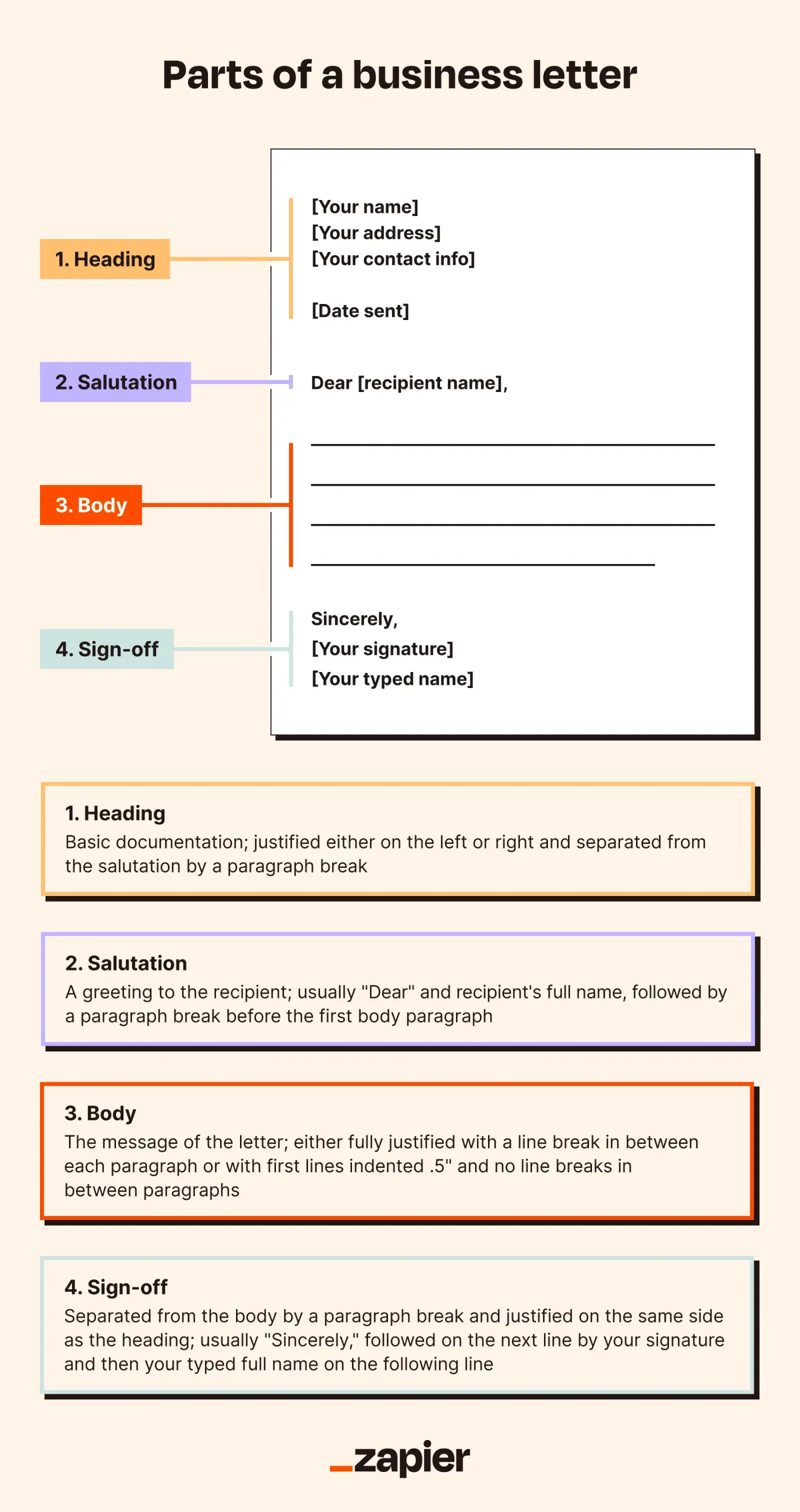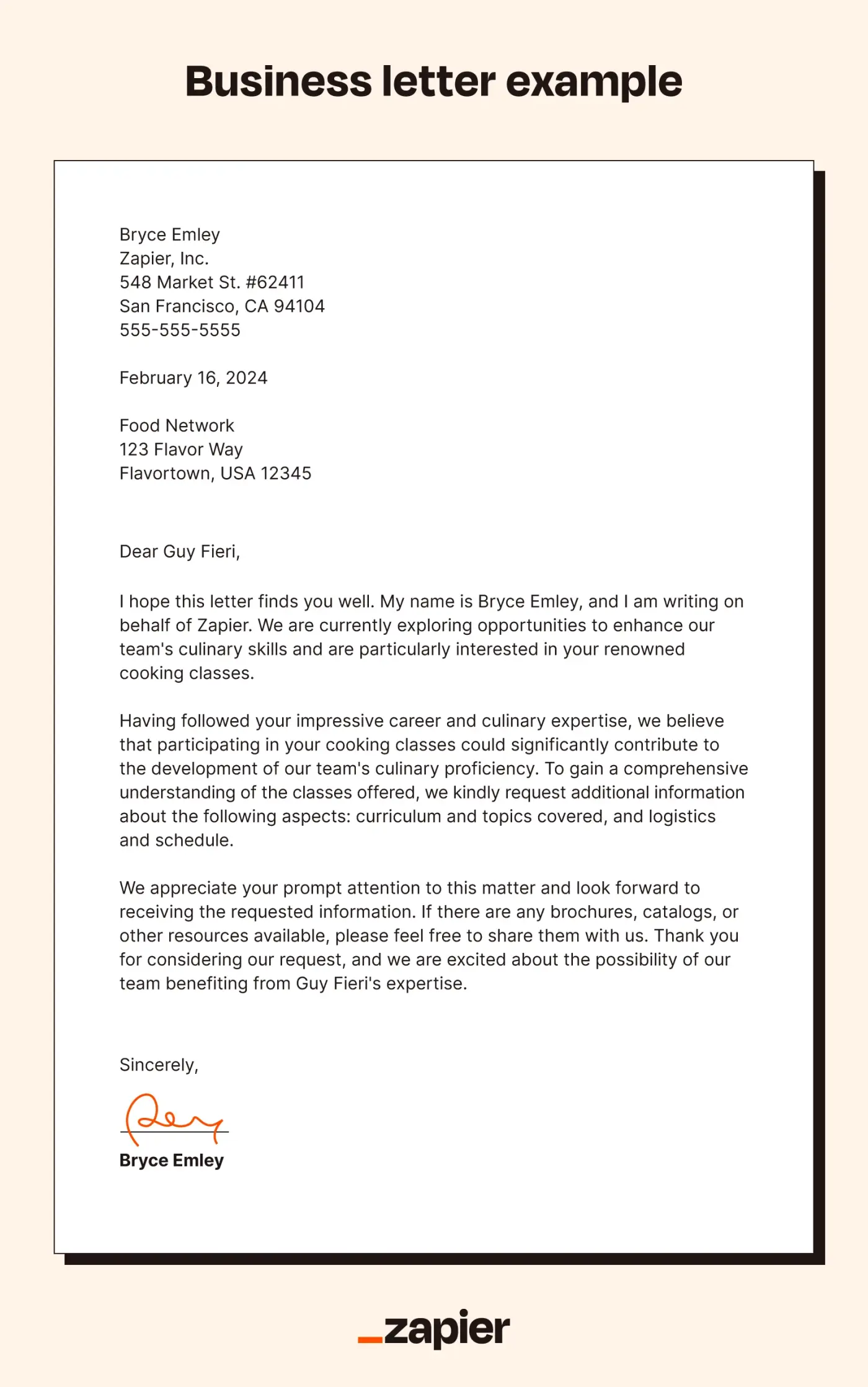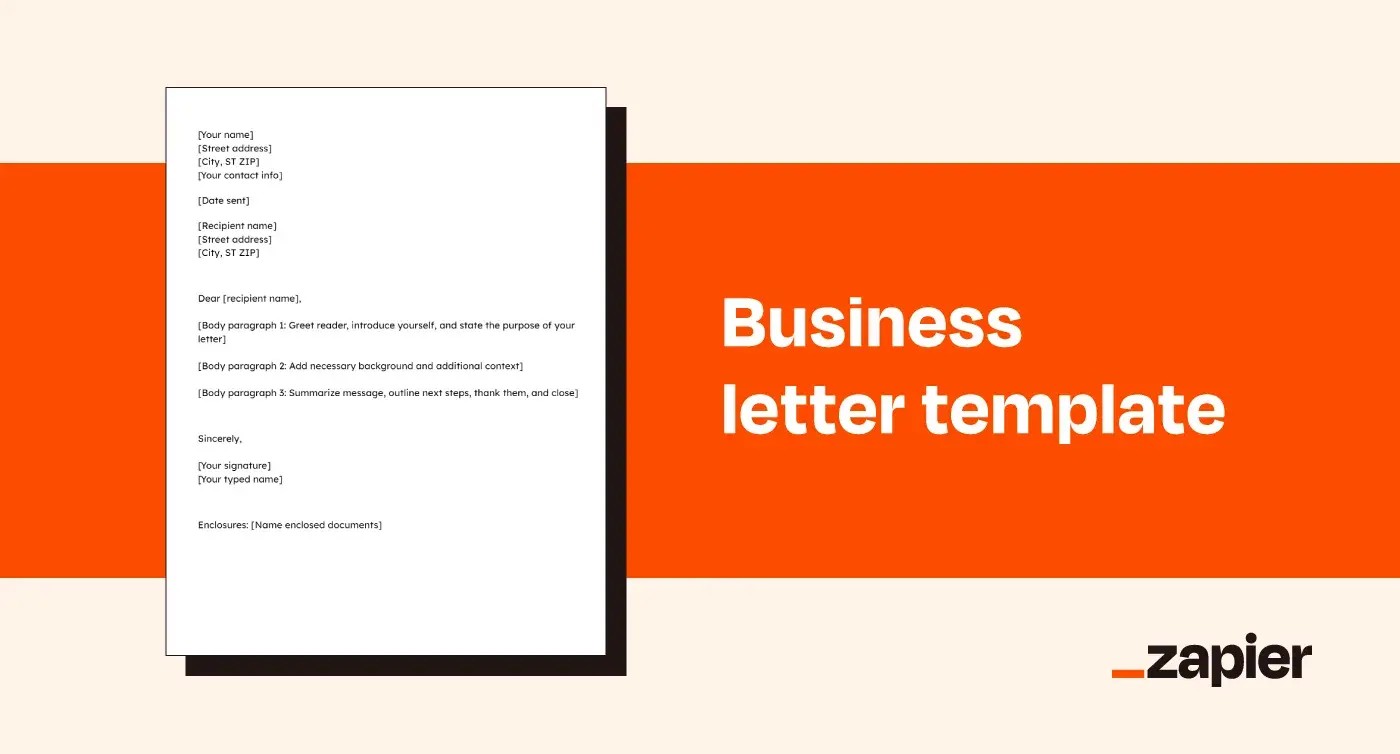There may be no more comically vague term in the entire business world than the word "business." It means so many things that it really means nothing, and yet you're reading this right now because you probably have a specific business-related need.
You might argue that any letter composed in a business setting could be considered a business letter—and you'd be more or less correct. But with such an impossibly wide and unspecific range of applications, how are you supposed to do business lettering right?
Whatever purpose you have for engaging in this epistolary practice, there are certain rules, expectations, and formatting specs you need to know. Here's how to write a business letter of just about any type in a way that gets the job done.
What is a business letter?
A business letter is formal written communication between organizations, individuals, or external entities for specific professional purposes. (Slightly) less vaguely speaking, a business letter can do things like give requested information, make inquiries, make proposals, accompany invoices, address concerns, or convey intention.
These communications usually follow standardized formats and include expected elements like formal salutations, signatures, contact information, and a body of text focusing on one specific business purpose. It won't likely get you fired if you don't rigidly follow all these rules, but abiding by format expectations can reduce variables, keep your messaging professional, get your message across clearly, and even enable automation.
Types of business letters
There are a lot of different types of business letters because a lot of business things happen at businesses. That's just business facts.
But there are a handful of typical business letter purposes and structures for use cases, ranging from sales to hiring to procurement. Here are some of the most common ones.
Sales letter: Sales teams use these to pitch a product or service to potential customers.
Business inquiry: This letter is a formal way to ask a company for more information about their products, services, or job openings.
Request for information: Called an RFI for short, this is used to gather detailed information about potential vendors' products or services.
Cover letter: This general introduction letter summarizes an attached document like a resume or job application.
Offer letter: A hiring company sends this to successful job applicants to formalize the hire and outline the details of the position.
Letter of recommendation: A more senior professional who knows you sends this with your job application to get the hiring committee hyped to hire you.
Acknowledgment letter: You can use this boilerplate letter to let someone know you've received something from them.
Letter of resignation: A more formal way to say "I'm quitting," this gives HR dated documentation of your timeline and possibly rationale for leaving.
Parts of a business letter
While the details will vary pretty widely depending on what you're writing it for, there are four essential parts of a business letter that will almost always be there: heading, salutation, body, and sign-off. Here's what goes into each.

1. Heading
These basic details should open any business letter. They'll generally be left-justified at the top of the document, listing:
Your name
Your return address
Your contact information
The date the letter was/will be sent
Recipient's address (optional)
In some cases—particularly if you're sending a physical letter to a company—it can be helpful to include the recipient's address in the heading as well. In the digital age, it's not as important since you'll likely send this as an email or attachment. When in doubt, it doesn't hurt to include it, as it can also show you've done your homework.
Letters don't usually have big title headers labeling them as something generic like "Business inquiry" or "Business letter." But if you're writing one for a well-defined purpose for documentation, like a letter of resignation or offer letter, you could consider it.
2. Salutation
Below your header, you can't just jump right into requesting a quote or quitting a job—you've got to greet the reader. This will go on its own line, equidistant from the heading to the body.
In a business context, you want to be formal but not stilted. "Hey!" won't be taken seriously, while "Greetings, Sir" comes across like an alien trying to act like a human.
"Dear _____," is always a safe choice. Fill in the recipient's full name or replace their first name with a title like "Dr." or "Professor." Always use a name if you can find one. If you can't, use a generalized stand-in like "Dear [company name/department] hiring committee" or "Dear [company name] board of directors."
When in doubt, you could do worse than "To whom it may concern," but it's a little on the impersonal side and should be avoided if possible.
3. Body
If the heading is the table and the salutation is the plate, the body of the business letter is the big steaming scoop of casserole. This is where you make your case, ask your question, or shoot your shot. This usually takes up the largest portion of the letter, which kind of muddies my analogy.
Body sections can be as short as one sentence—something like "We have received your request and will respond within two business days." But in most cases, they'll be upwards of a few paragraphs. Again, there are no rules for the number of paragraphs. But for longer messages, it can help to map out three:
Paragraph 1: Greet the reader, introduce yourself, and state the purpose of your letter.
Paragraph 2: Follow up with the details of your message. Any background info they need to know or extra context can go here as you make your point.
Paragraph 3: Wrap it up with a quick summary of your main point, let them know what they can do next or what you'll do next, thank them, and close out.
Here are a few pro tips for writing this section:
Focus paragraphs. Each paragraph after the introduction should have one specific focus. Bonus points if you can convey what each paragraph is about in the first sentence.
Be concise. Most professionals have a lot on their plates (to bring the analogy back). Stick to the point, and only include details that are absolutely necessary in the context of the letter.
Adapt the voice. Business communication should be formal and polite but not stilted or effusive. However, if the company you're writing to has a very clear voice and you're writing for a personal matter (e.g., applying for a job), consider adapting your voice to match theirs.
Close it out. Wrap up the body with a conclusion paragraph that succinctly summarizes everything you just said in a couple of sentences.
Next steps. Make sure your recipient knows what to do once they've finished reading. Include actions ("See attached…"), requests ("Please let me know…"), expectations ("I look forward to your response"), or suggestions ("Please consider…").
4. Sign-off
Once you've made your point, all that's left is to stick the landing and get out of there. Every business letter should have a closing section that shows you're finished and gives the recipient clarity on next steps.
Sign-off: Like "Dear" in the salutation, "Sincerely" is a safe sign-off to follow the body with. Depending on the context and familiarity, alternatives like "Best" or "Gratefully" can also work, but this isn't somewhere you want to take risks.
Signature: In the digital age, we don't hand-sign many non-legally binding documents, but if possible, it's a good idea to include one beneath your sign-off. For physical letters, sign it here. For digital ones, consider adding a signature by drawing or typing in a cursive font.
Typed name: Since most people's signatures are borderline unreadable, type up your name below the signature. This leaves no question as to who you are and how to spell your name.
Enclosures: Lastly, if you have any enclosed documents accompanying the letter, don't forget to include them.
How to write a business letter
So you know what a business letter is, what goes into it, and how to structure it. Now it's time to write it. Here's how to write a business letter for just about any occasion in six steps.
1. Identify your purpose
Before you write a word, you should have a clear purpose for your letter. If it doesn't fall into a neat category of letter types, see if you can at least summarize your purpose in one sentence.
Once you have a defined purpose, translate it into words you can inject into your first body paragraph. Your purpose should encompass your needs, who you need to communicate those needs to, and why that person is relevant to those needs.
2. Find a contact
Every letter needs a recipient. While you can employ the generic "To whom it may concern," that lack of specificity also signals to the recipient that you're not invested enough to know who you're talking to.
Before you get started, try to find the contact you need. Look to mastheads, contact pages, staff listings, or About Us pages for listings of personnel by role. Or, have a bot do it for you. AI sales assistant tools like contact crawlers can drag the internet for relevant contacts in a matter of seconds.
3. Follow a consistent format
Business letter formatting should be like underwear: foundational but unnoticed. If the reader is thinking about your formatting, you've probably done something wrong.
The key to formatting is consistency. Maintain the same font, size, spacing, and margins throughout the document. When in doubt, left-justify all the text, but you can also consider these professional letter format options:
Block: Everything is left-justified with no additional indents to the first lines of paragraphs. Instead, you'll have an extra space between paragraphs. To avoid huge white spaces, you'll want to maintain 1"-1.5" paragraph spacing—ideally 1" or 1.15". This is a can't-miss standard option.
Modified block: A variation on block formatting, this one's a bit more dynamic. Start with block formatting, but add a twist: move non-paragraph elements like the heading, sign-off, and signature to the right margin. It's a small difference but a more visually engaging one.
Semi-block: Like block formatting, everything is left-justified in this format. The difference is that new paragraphs have indented first lines, generally 0.5". Since this visually differentiates new paragraphs, you should cut out any additional spaces between paragraphs. Keep this one at 1.5"-2" paragraph spacing, ideally double, to promote readability. This is a more formal option.

4. Write with intention
You'll spend most of your time in the body section, and that's where you'll really drive your point home. Every paragraph should contribute to the purpose you identified from the outset, and every word should advance your goal.
As you write your body paragraphs, it's crucial to maintain a consistent, professional tone. Keep it in the second person—since you're writing to an individual, address them as "you" when you need to refer to them.
Not sure how to get your tone right? You can always try using an AI text generator or chatbot to help out by:
Writing an effective introduction
Turning your rough ideas into full letter bodies
Giving you new phrasing options
Rephrasing your own words into a different tone
Adding humor or other personal touches
Giving you suggestions for improvement
5. Keep it short
This goes for your paragraphs and your letter as a whole. No one wants to sift through huge blocks of text to get to the point of a letter they know has an actionable intention.
There's no hard-and-fast rule here—it's really more of a feel. But generally try to limit paragraphs to four to six lines. If possible, keep the entire letter to one side of one page.
If you're sending your letter by email or webform, compose it in a text editor like a Google Doc first. This should give you access to more formatting features and a visualization of what fits on one page.
6. Copy edit
Do I believe that meaning is fluid and grammar is a subjective construct? Yes and yes. Do I believe business letters should be as grammatically sound as possible? Also yes.
Your letter may not have to have 100% perfect grammar and formatting in order to communicate your message effectively, but each mistake is like another ding in your authority armor. You can try composing your letter in or running it through one of the many writing or editing apps on the market. While Word and Google Docs have their own native spelling/grammar checkers, these AI-driven applications can pick up on much more nuanced linguistic quirks and even suggest clearer phrasing alternatives.
Business letter format example
By now, you may be wondering what a business letter looks like in practice. More specifically, you may be wondering what an AI-generated RFI about Guy Fieri's free Food Network cooking classes looks like. Incredibly, that's exactly what I've got for you in this very section.
For reference, I used standard block formatting.

Business letter template
This simple business letter template should give you the foundation you need for just about any use case. Just replace the text with your information, delete the sections you don't need, copy edit, and you're ready to go.
Here are a few additional tips for customizing it:
Font: We opted for a Zapier-style font, which can suit more casual digital business messaging. But for an even more formal look, opt for the traditional Times New Roman.
Format: This is the standard block format, but feel free to adjust to modified block or the more traditional semi-block.
Date: This should be the date sent, not necessarily the date you start the draft.
Recipient contact information: Exclude this if it's not available or relevant.
Enclosures: Exclude this if you're not enclosing any additional documents.

How to write a business letter with automation
Now that you know how to write a business letter, it's time to throw in a little automation to make it even easier. By using Zapier's no-code automations, you can build your own custom business letter workflows that combine your favorite applications.
For example, you can create and autopopulate a Google Docs template straight from the other apps you use. Here are a few other ideas to get you started.
Automatically create a Google Docs document every week
Send email via Gmail when there is a new Google Document
Create new Google Docs before a Google Calendar event
Zapier is the leader in workflow automation—integrating with 6,000+ apps from partners like Google, Salesforce, and Microsoft. Use interfaces, data tables, and logic to build secure, automated systems for your business-critical workflows across your organization's technology stack. Learn more.
Business letter FAQ
How do you write a simple business letter?
Here's how to write a simple business letter:
Put your name and address in the top-left corner.
Below that, type the full date.
Follow that with the recipient's contact information.
Start the message with a salutation like "Dear [name]."
Open the message body by introducing yourself and the purpose of your letter.
Write as many paragraphs as you need, but try to keep it to one page.
Below the body, write a sign-off like "Sincerely," followed by your signature and then your typed name.
If enclosing documents, list enclosures below that.
What is the correct format for a business letter?
Most business letters have a block format. This has 1" margins on all sides, standard 12-point font, single or 1.15" spacing, a space between paragraphs with no first-line indentations, and left justification for all text.
How do you start a professional letter?
A professional letter should start with "Dear" followed by the recipient's full name. If the recipient has a title like "Dr.", include that as well. If you don't have a specific recipient, use "To whom it may concern."
Related reading:






